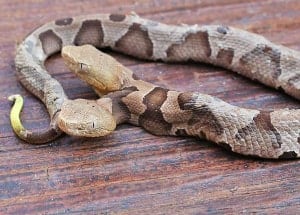The sight of the copper snake in your yard can be quite disturbing. However, it is too early to start worrying, as you can fight it. Definitely, this is not the most dangerous snake for humans, but facing it on your property is still unpleasant.
Due to this review, you’ll get the information on what kills copperhead snakes, how to get rid of them, and how to repel these serpents with the help of different treatments.
[wpsm_titlebox title=”How to Get Rid of Copperhead” style=”main”]
- Remove Food Sources. You will have to tightly close all trash cans outside that may contain leftover food.
- Seal the Entry Points. Seal any holes in your walls, garage, or basement.
- Get rid of their favorite hiding places in and around your home.
- Place a snake repellent around the yard.[/wpsm_titlebox]
Everything You Need to Know About Copperhead
Copperhead (Lat. Agkistrodon Contotrix) is a poisonous snake from the Viper family (lat. Viperidae). Copperheads are medium-sized reptiles, averaging from 2 to 3 feet (0.91 m) in length. As stated in Smithsonian National Zoological Park observations, female snakes have longer bodies than males; however, males’ tails are longer proportionally.
The back is colored yellowish-bronze or reddish with transverse yellowish-brown spots, while the sides are light brown. The triangular head has a pronounced copper color.
These reptiles have a vertical pupil like a cat, and the irises can be orange, brown, or reddish-brown. The muzzle is broad and blunt. The body is muscular and massive.
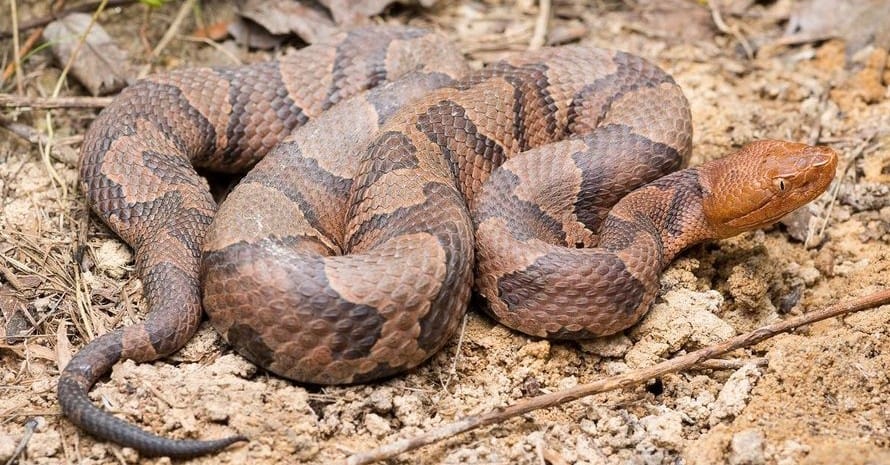
The mating season happens two times a year in February and in late August and lasts for three months. During this period, males can enter ritual battles, and the losing snakes rarely challenge again. Females can also fight with prospective partners.
These reptiles are born alive, as the eggs are incubated in the mother’s body. Offspring has fangs and poison, as strong as in adults. The length of the young copperhead is 8 to 10 inches (ca. 25 cm). They feed mainly on caterpillars and other insects. The food of adults consists of field mice, birds, and probably frogs.
The area of distribution of the copperhead snake extends from 45 degrees north latitude to the extreme south of the eastern states of North America. The place of residence is marshy areas, mainly vast pastures, shady meadows with tall grass.
The movements of this snake are much faster than the movements of the terrible rattlesnake, but still quite lazy; by its character and habits, it does not differ from other quickly irritating poisonous snakes.
When a person approaches, the snake takes an offensive pose, raises its triangular head, twirls its tongue, and moves from side to side with the tip of the tail. A copperhead does not bite either in a stretched position or when lying curled up. It poses danger only when lying, arched like the Latin letter S.
Copperhead vs Garter Snake
These two types of snakes have very little in common. Unlike the copperhead, garter snakes are small, non-venomous creatures that live mainly in gardens and meadows. Such reptiles only grow to 1-2 feet in length.
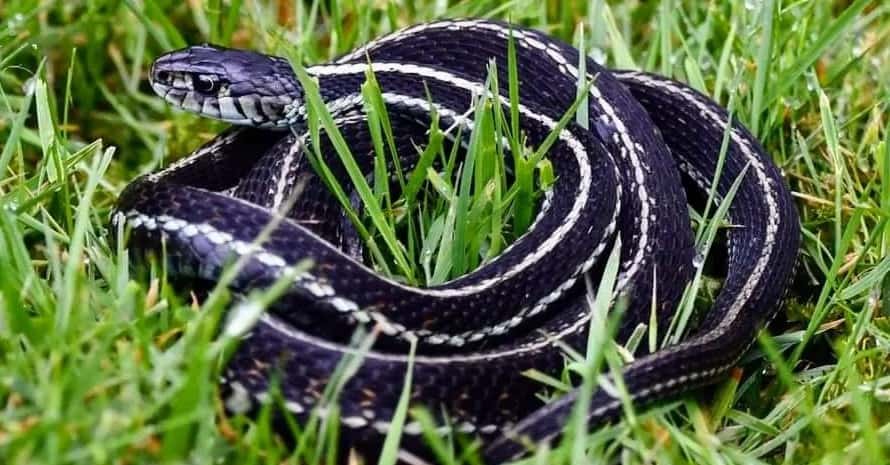
The most distinctive feature is three long yellow stripes that extend vertically down the body. Fully mature garter snakes can vary in color from gray to olive green.
Due to all these factors, an ordinary garter snake contrasts sharply with a reddish copper head, which is a much larger, stronger, and more aggressive snake.
Copperhead vs Rattlesnakes
The most significant difference between these two snakes is the rattlesnake’s unusual tail. Also, these snakes have different head shapes: the rattlesnake’s head resembles a diamond in form. This reptile also has characteristic flared nostrils. The rattlesnake is either of light brown color or brown with dark brown spots on the body.
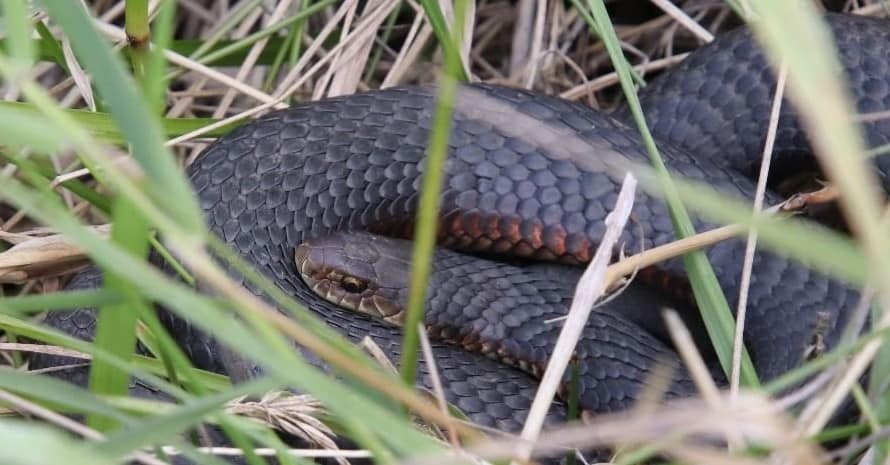
Furthermore, rattlesnakes live in a dry environment, such as the North American southwest. You can meet this reptile in the desert or in the bush. Rattlesnakes are one of the giant snakes in the US territory. They are from 1 to 8 feet long. Meanwhile, the copperhead is significantly less.
How Dangerous Are Copperheads?
Unlike most poisonous serpents, copperheads do not make warning movements, they attack immediately. They have haemotoxic poison, which means that bites of this snake can lead to tissue damage.
These bites can cause sharp pain. However, the venom is not extremely dangerous, because it is rarely deadly to people. Anyway, the poison is dangerous for kids and older adults, and anyone who has been attacked by this reptile needs medical attention.
How to Get Rid of Copperhead Snakes?
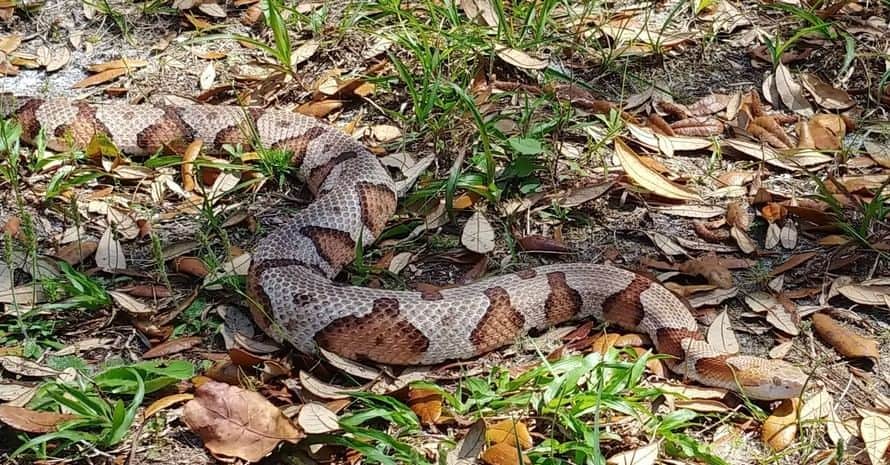
Step 1: Remove Food Sources
The first step is rather unobvious. You will have to tightly close all trash cans outside that may contain leftover food. Leftovers from your table attract rodents, which in turn are food for snakes.
If you have pets, feed them in the house and do not leave their food outside. So, while mice and other rodents are your frequent guests, it will be difficult for you to keep copperhead snakes away.
Step 2: Seal the Entry Points
Getting rid of copperheads, don’t forget to close all entrances to the house for them. Seal any holes in your walls, garage, or basement using a sealing gun and sealant to stop serpents from seeking shelter in your home. Remove all foreign objects from your house, garden, and yard.
Eliminate the piles of stones, and cut the high grass. Remove all objects that could become a house for copperheads or rodents. Raise piles of lumber and woodpile at least 18 inches from the ground to reduce areas where snakes can live.

Step 3: Getting Rid of Copperheads
One of the simplest ways to destroy serpents is to get rid of their beloved shelters inside and around your house. Greens should be low so that copperhead snakes would have fewer spots. Besides, when you distribute snake repellent all over the yard, you create unpleasant conditions for them.
In turn, you’ll notice a chain reaction: the first reptile has disappeared, and new snakes are reluctant to settle in grasses where repellent covers.
The second two alternatives are not much different from past references. If you want to know how to catch a copperhead and set it free after, special traps can help you. Snake traps cover glue shields and cages in which the snake is stuck.
Then you can free the snake in any place that’s far from your house. Similarly, a team of professionals will either exterminate the reptile or catch it and release it in another location.
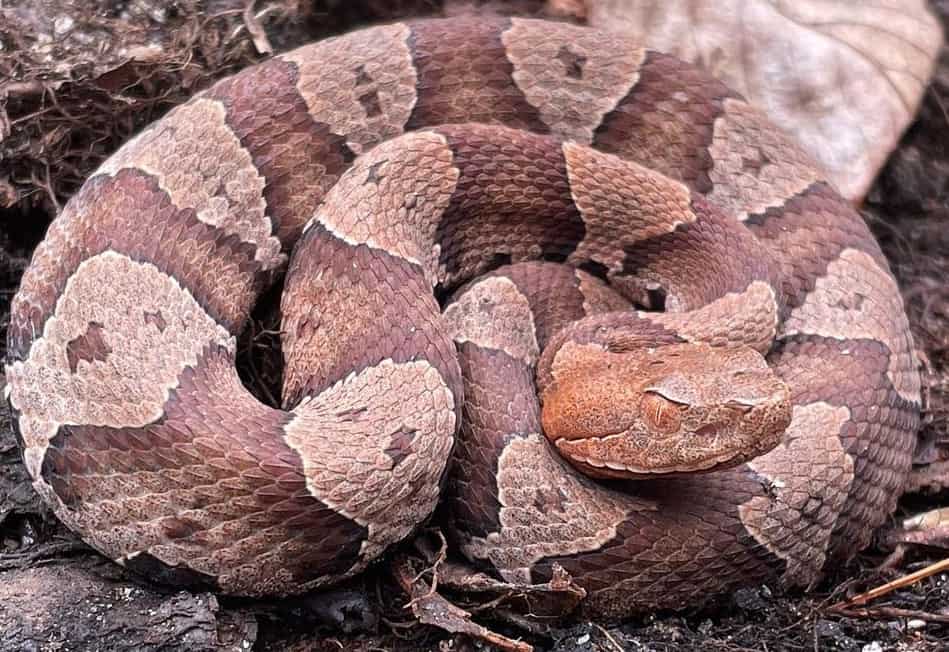
You can try mothballs: copperhead snakes could leave because they may not like the smell. However, you’ll deal with chemicals, and the method does not count as reliable.
Try essential oils if you are searching for more eco-friendly and simple answers to the question of how to keep copperheads out of your yard. They are considered environmentally friendly alternatives to unrelenting chemicals.
Some essential oils, including cinnamon, peppermint, cloves, and castor oil, have relatively strong odors and can be effective in protection against snakes. Soak a few cotton balls overfilled with clove oil, cinnamon oil or eugenol in places subject to snake activity, or add 5 to 10 drops of a blend of essential oil to a gallon of water and diffuse in the backyard. However, this method can be less effective than chemicals and traps.
[su_note note_color=”#dbe1d3″]Related Post: Best Snake Gaiters to Secure Your Legs From Bites[/su_note]
Top 5 Copperhead Treatments
You can get some treatments if you want to get rid of the serpents and avoid killing copperhead snakes. They will help you scare snakes away from your site.
1. Frabill 1271 Fishing Equipment Nets & Traps — Best Humane Copperhead Trap
[amazon box=”B002QFU5IO” template=”vertical” tracking_id=”how-to-get-rid-of-copperhead-20″ button_text=”Check price on Amazon”]
Specifications:
- Material: Blend
- Size: One Size
- Item Weight: 1.05 Pounds
- Item Dimensions LxWxH: 10 x 9.75 x 9 inches
- Target Species: Minnows
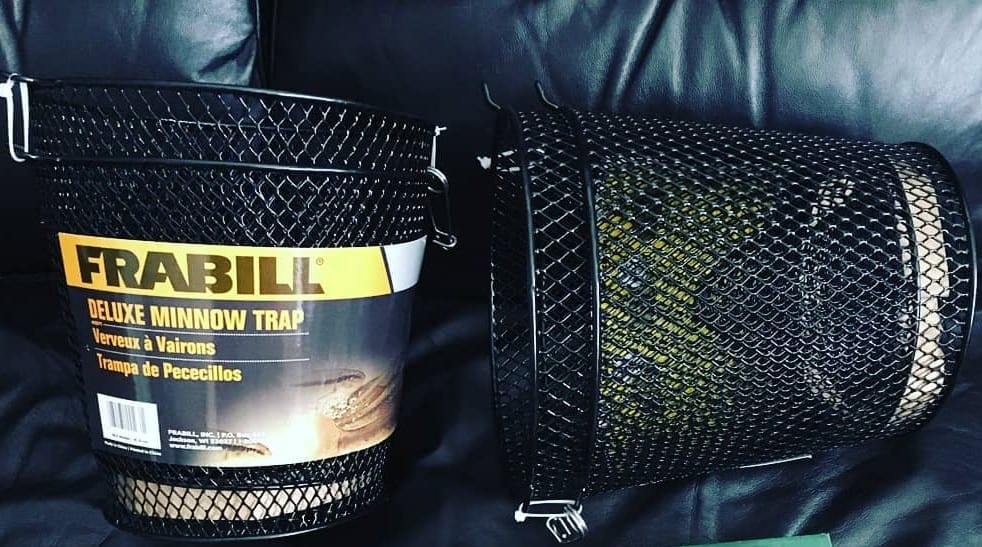
If you notice a snake in your garden or basement, catching and releasing it elsewhere is an effective and humane way to deal with it. You can pick it with the help of a snake trap of a high technical level or, also, in quite a cheap way — using a nest and eggs in the form of bait.
The trap is made of galvanized metal. Black color helps mask the trap. The net is quite dense, so the snake will not reach you when you catch it. The snake will get to the bait quickly, thanks to the two-part design and its shape.
| Pros: | Cons: |
|
|
2. Catchmaster Baited Rat, Mouse and Snake Glue Traps — Best Copperhead Glue Trap
[amazon box=”B078YD8YRD” template=”vertical” tracking_id=”how-to-get-rid-of-copperhead-20″ button_text=”Check price on Amazon”]
Specifications:
- Material: Plastic
- Number of Pieces: 12
- Item Weight: 8 ounces
- Item Dimensions LxWxH: 3.85 x 0.5 x 0.43 inches
- Target Species: Cockroach, Cricket, Mouse, Rat, Snake, Spider
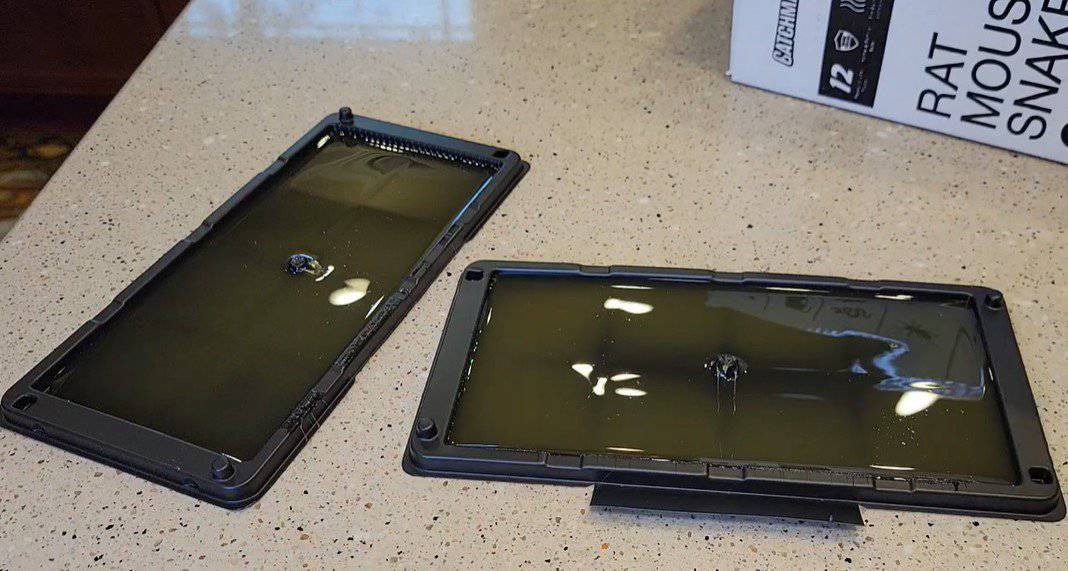
The brand has been creating products for more than 60 years that are designed to control insects, snakes, rodents, and other pests. It is a leading manufacturer of intelligent pest management solutions.
You can use the item flat, folded, or in the shape of a rectangular tunnel. You do not need bait. You can just get the product out of the box and use it without prior preparation. The package contains 12 traps, each of them is covered with a thin plastic film. Active substances are not toxic and safe for humans.
| Pros: | Cons: |
|
|
3. Victor VP364B Way Snake Repelling Granules — Best Copperhead Repelling Granules
[amazon box=”B07N1GMVWL” template=”vertical” tracking_id=”how-to-get-rid-of-copperhead-20″ button_text=”Check price on Amazon” button_detail=”https://shareasale.com/r.cfm?b=410159&u=2583381&m=43235&urllink=www%2Edomyown%2Ecom%2Fvictor%2Dsnake%2Dway%2Dp%2D23262%2Ehtml%3Fsub%5Fid%3D23263&afftrack=how%20to%20get%20rid%20of%20copperhead” button_detail_text=”Check price on DoMyOwn”]
Specifications:
- Active Ingredients: Naphthalene (7%) and Sulfur (28%)
- Item Form: Granules
- Item Weight: 4.15 pounds
- Package Dimensions: 3.3 x 8.4 x 12 inches
- Target Species: Snakes
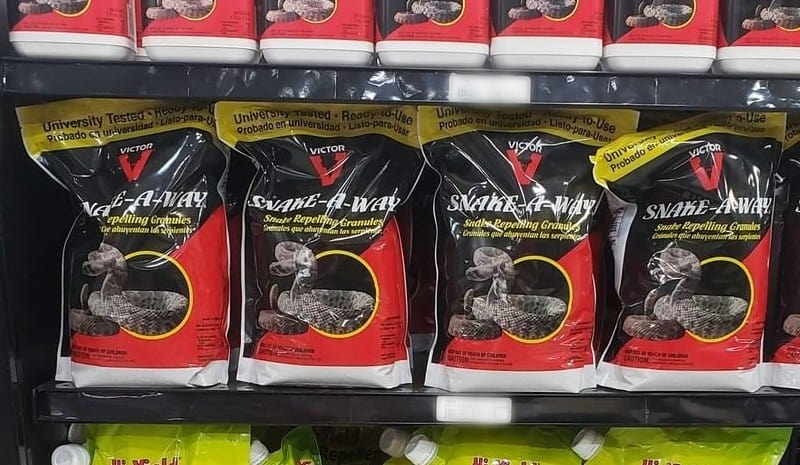
A third-party lab has tested Victor Snake-A-Way Repellent as an effective repellent against poisonous and non-poisonous snakes. You can use it for houses, basements, sheds, trailers, garages, and flower beds to save them from the invasion of various types of snakes.
The Jacobson organ is a special olfactory organ used by snakes that helps them detect environmental irritants.
Repellent granules affect this organ, and snakes leave the protected area. How to deter copperhead snakes with the help of the granules? The product is easy to use: just put on gloves and spread the granules around the perimeter. When choosing the strip’s width, you need to focus on the size of the reptile that you want to drive away.
| Pros: | Cons: |
|
|
4. Snake Defense Natural Snake Repellent — Best Copperhead Repellent Spray
[amazon box=”B075283X6M” template=”vertical” tracking_id=”how-to-get-rid-of-copperhead-20″ button_text=”Check price on Amazon”]
Specifications:
- Scent: Cinnamon
- Item Form: Spray
- Item Volume: 1 Gallons
- Item Weight: 8.69 Pounds
- Package Dimensions: 11.3 x 9.25 x 6.14 inches
- Target Species: Most common types of Snakes including Garter Snakes, Rattlesnakes, Copperheads, and many more
One Snake Defence Natural Snake Repellent bottle is economical and creates a 3-foot barrier around the protected object.
The product contains various essential oils (cloves, peppermint, and cinnamon oil). Snakes don’t like strong odors. Spraying is convenient and very easy. It will not harm your pets and children. This item is an excellent alternative to granules.
| Pros: | Cons: |
|
|
5. Ultrasonic Pest Repeller, Gopher, Mole, Snake, Mouse, Rodent Repellent — Best Multifunctional Repellent
[amazon box=”B0877XM6PH” template=”vertical” tracking_id=”how-to-get-rid-of-copperhead-20″]
You will receive two devices in one package. They are conveniently placed in the ground and will be powered by solar energy. The spray is a big plus because you do not need to charge it.
The tool repels snakes and other pests due to ultrasonic waves. With this tool, you will scare away not only the copperhead but also its potential food. Ultrasonic Pest Repeller is the most environmentally friendly and easy to use tool.
| Pros: | Cons: |
|
|
How to Prevent Copperhead in the Future?
After using one of the methods to repel copperheads, you need to consider how to prolong the effect. To keep your garden and home safe in the future, you can continue to cut the grass and prevent it from growing tall regularly.
Also, continue to cover food waste tightly to prevent mice from appearing in your area. It would be best if you get rid of all kinds of things in piles, among which snakes can nest. You can try copperhead repellent plants. It can be, for example, lemongrass, because it has a strong smell.
FAQ
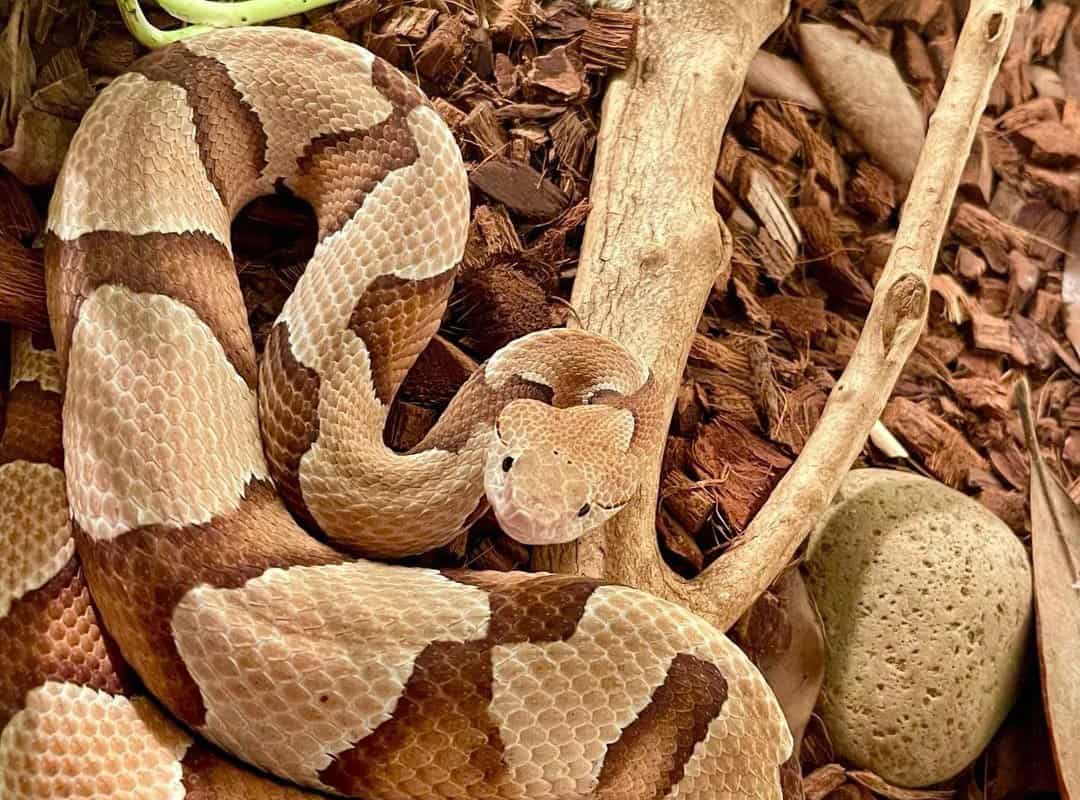
In this section, I will answer the most frequently asked questions about copperhead snakes. It will help you learn even more about these reptiles.
[su_note note_color=”#dbe1d3″]Related Post: Best Snake Proof Boots [/su_note]
Are Copperheads Aggressive?
A copperhead is not considered an aggressive snake. However, do not annoy or frighten it, as it will most probably attack. Furthermore, it doesn’t make any warnings but attacks immediately.
Do Copperhead Snakes Climb Trees?
Copperheads cannot climb to great heights, unlike a lot of other types of snakes. However, in search of food, they can climb low trees or bushes.
How Poisonous Is a Copperhead?
Copperhead infestation rarely causes death from snake bites. Their venom can severely injure local tissues and can cause serious secondary infections. Copperhead’s poison can be fatal, but often the snake injects very little poison when it bites a human.
What Animal Kills Copperheads?
Many animals feed and prey on copperheads. They include kingsnakes, alligators, wild cats, predator birds like owls and hawks. Opossums and coyotes also hunt the copperheads.
Where Do Copperheads Usually Hide?
These reptiles prefer to live close to a food source in wooded areas, tall grass. They can also hide in rotten wood and piles of leaves.
[su_note note_color=”#dbe1d3″]Related Post: Best Snake Chaps to Protect Your Legs [/su_note]

Select a Treatment and Get Rid of Snakes
The venom of a copperhead snake, in most cases, is not fatal to humans. However, it is worthwhile to beware of them, and it is advisable not to be bitten. These snakes live in secluded places of your house and on sites with tall grass or bushes. They prey on mice and other rodents that may be attracted by leftover food in your yard or inside the house. So getting rid of snakes is an intricate work with cleaning your place and using repellents.
You are welcome to share your thoughts on the copperhead fighting techniques. Please, leave your comments in the section below.
References:
- Copperhead (Tennessee Wildlife Resources Agency):
https://www.tn.gov/twra/wildlife/reptiles/snakes/copperhead.html - Haemotoxic snake venoms: their functional activity, impact on snakebite victims and pharmaceutical promise(National Center for Biotechnology Information):
https://pubmed.ncbi.nlm.nih.gov/28233897/ - Snakes In and Around the House(Oregon State University):
http://npic.orst.edu/pest/snake.html

